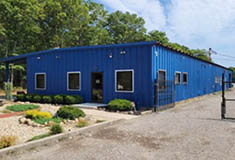Commercial Classroom: Office Market - by Edward Smith Jr.

Disaster or opportunity?
“Marker Reports” has reported the U.S. market closed 2023 with office sales being 60% less than 2022. In a CNBC interview with Dan Peebles, CEO of Peebles Corporation, he cited that, “Washington, DC real estate values are down 60 to 70% in commercial office buildings. Los Angeles down 70% or more and San Francisco down 60, 70%”. This, decreasing future assessed values of office properties, will reduce the real estate tax revenues for many cities.
In Boston, MA Mayor Michelle Wu is petitioning for a temporary increase in the city’s tax rate ceiling for commercial buildings to deal with the city’s $1 Billion deficit from these plundering office building values. This is being done to be able to continue city services without increasing real estate taxes on residential properties and to insure that homes in the city are affordable.
In Minneapolis, Minnesota, according to a Cushman and Wakefield report 31% of all downtown office space is vacant, largely due to hybrid work models and downsizing of offices. The 31 story, 850,000 square foot American Financial Center is expected to be completely vacant within the next 17 months. It is anticipated the cost to make the necessary improvements to turn the property into a competitive multi-tenant building will be at least $10 million.
Meanwhile the owner of the tower, which is now assessed at $71 million by the city, (which they bought in 2016 for $200 million) will have to pay millions annually in property taxes, energy costs and maintenance while trying to attract tenants.
Three office building owners in the city have gotten bids as to what it would cost to demolish their office buildings, with the thoughts that the highest and best use of their properties would be to build apartments on their sites.
The other problem with the market is the high interest rates that are affecting building owners’ ability to obtain loan extensions and workouts and are expected to increase loan defaults and create more foreclosures throughout the country.
Nationwide the office vacancy rate was 18.3% in December 2023.The latest Colliers report indicates office vacancy in New York City has reached a new high in the first quarter of 2024 at 18.1%. Most major cities are struggling with the same problems. The ripple effect on cities is a reduction in the collection of real estate taxes on commercial buildings. This could lead to increasing residential real estate taxes to offset these budget deficits.
According to Goldman Sachs estimates from late 2023, the share of U.S. workers still working from home is in the range of 20%-25%. The post-pandemic work-from-home, at least part time, seems now to be permanent, and is significantly slashing the need for office space.
“Commercial Edge” gives us a good overall view of the market. Nationwide the average office rents are currently at $34.47 per square foot with vacancies at 17.90% and average sales prices at $179.00 per square foot. Below is a chart of a dozen major cities and how they are faring this year, as of February 2024.
| Rent per SF | Vacancy % | Sales per SF | |
| Manhattan | $71.53 | 16.80% | $77.00 |
|
San Francisco |
$59.81 | 24.00% | $941.00 |
| CA Bay Area | $54.12 | 20.80% | 0 |
| Boston | $45.62 | 12.20% | $223.00 |
| Los Angeles | $41.78 | 16.00% | $91.00 |
| Seattle | $37.87 | 22.50% | $430.00 |
| New Jersey | $34.47 | 18.70% | $122.00 |
| Philadelphia | $31.22 | 15.5 | $92.00 |
| Denver | $30.58 | 22.10% | $129.00 |
| Houston | $29.64 | 24.30% | $62.90 |
| Chicago | $27.62 | 18.00% | $117.00 |
| Detroit | $22.62 | 31.30% | $58.00 |
This shows us that half are at or under the national average rent. Ten of these cities have vacancy rates higher than the national average. The average sales per SF varies as it reflects specific buildings sold. Since we have only looked at two months' activity, we don’t know how many buildings were sold, is this just reflecting one sale or a consensus of several sales.
But there is a growing group of investors who are looking at the low prices as added value, a “once in a generation opportunity”. Many of these investment companies have been in the business for many years, have experienced various real estate cycles, and have no doubt these conditions will turn around over time. They are convinced now is the time to invest in commercial real estate.
Black Rock Real Estate Research is of this opinion. As are SL Green Realty who has announced a $1 billion opportunity debt vehicle and are targeting New York City properties. RXR and Ares Management have formed a $1 billion fund to buy distressed office assets. Ethan Penner and Chad Carpenter launched a new REIT raising $1 billion to fund debt solutions for office owners and investors. Goldman Sachs has a new $2.6 billion fund for commercial real estate lending.
In Don Peebles interview with CNBC he also said, “We’re an opportunity company, so we look to develop when markets are supply-constrained, and then we like to buy when we think there’s tremendous value. And what we’re seeing here in commercial office space essentially is a once-in-a-lifetime opportunity to buy. Nothing like this has happened since the early 1990s…”
With the current state of the office real estate market, it’s hard to imagine that office buildings will permanently be devalued, and it’s equally hard to think that things will return to how they once were. But what we do know is commercial real estate is ever changing, and it will adapt to new conditions.
Being optimistic, I look at these times as great opportunities for agents and brokers to help the struggling businesses out there, to downsize, if necessary, or to relocate and sign new leases. And to help building owners and investors to sell, buy and/or repurpose their buildings. This is when our clients need us the most!
Edward S. Smith. Jr. CREI, ITI, CIC, GREEN. MICP, CNE, e-PRO and CIREC Program Developer, is a Commercial and Investment Real Estate Instructor, Author, Licensed Real Estate Broker, Speaker, and a Consultant to the Trade.
Suffolk County IDA supports expansion of A&Z Pharmaceuticals


The evolving relationship of environmental consultants and the lending community - by Chuck Merritt
When Environmental Site Assessments (ESA) were first part of commercial real estate risk management, it was the lenders driving this requirement. When a borrower wanted a loan on a property, banks would utilize a list of “Approved Consultants” to order the report on both refinances and purchases.









.jpg)